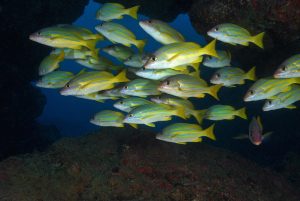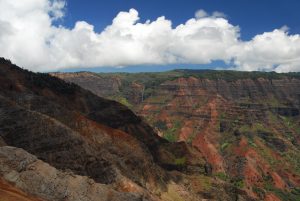The Hawaiian Islands stretch across a swath of the Pacific Ocean starting with the “Big Island” of Hawaii to the southeast and continuing to the north and west with Maui, Oahu and Kauai. Geologically, this island chain actually continues beyond nearly to the Bering Sea. It is an archipelago that represents a unique culture and a south pacific tropical paradise. This is the land of luaus, rain forests, volcanos, palm trees and waterfalls. But there are other secrets that are to be uncovered here.
Words and photos by Michael Salvarezza and Christopher P. Weaver
Eighteen miles west of Kauai and 138 miles southeast of the closest Northwestern Island lies the privately-owned island of Ni’ihau, measuring six by 19 miles, with fewer than 200 residents. It is known as the “Forbidden Island” because the owners have traditionally refused any requests by outsiders to land on the island. This lonely rock in the Pacific Ocean has thus taken on an aura of mystery and intrigue.
For divers, the waters swirling around this arid rock island conceal underwater wonders that make the journey by boat from Kauai worth the effort. And, make no mistake, it is an effort.
The journey across the Kaulakahi Channel between Kauai and Ni’ihau is intimidating. It’s a 33-mile voyage from the docks on the southern shores of Kauai to Lehua Rock on the north side of Ni’ihau. Because of the perpetually rough waters here, trips to Ni’ihau only run a few days a week between late spring and early autumn.
The trip to Ni’ihau is typically fairly smooth but it’s the return trip, when the boat pounds against the waves driven by prevailing winds, that really tests a diver’s sea legs.
Our trip to the Forbidden island began with a 6am departure across a rolling sea. Two hours later we were ready to dive. The first dive at Ni’ihau was at a place called “Vertical Awareness”, a 280-foot sheer wall that is home to lobsters, starfish, octopus and a plethora of native Hawaiian fish. Almost as fascinating as the marine life is the underwater topography and cerulean blue clear water.
As we snacked during our surface interval, we gazed at the dramatic rock formations of Lehua Rock, our intended second dive. There’s something about natural arches and jagged rock formations tumbling into the sea that makes us want to fill our memory cards with image after image. Soon, it was time to splash into the blue and see what wonders could be found below the surface.
Almost instantly, we were greeted by the star attraction of the Forbidden Island – an extremely rare and endangered, but curious, Hawaiian Monk Seal. Zooming out of the deeper waters, this nearly 7-foot-long male with a grey coat, white belly, and slender physique surprised us with a few inquisitive “flybys” just as we were beginning our dive.
Hawaiian Monk Seals, endemic to the Hawaiian Islands, are one of two remaining species of Monk Seals; the other is the Mediterranean Monk Seal. Another species, the Caribbean Monk Seal, is now extinct. The total population of these earless seals is around 1400, with most of the individuals living in the northern Hawaiian Islands. They are often seen on the beaches of Kauai and, occasionally, Maui. But for divers, the best opportunity to see them underwater is at Ni’ihau.
Human encroachment, disease, entanglement in fishing gear and low levels of genetic variation threaten this species today, although past hunting for seal skins is largely responsible for their precarious state.
Although it is strictly illegal to kill, capture or harass a Hawaiian Monk Seal, nothing prevents them from approaching divers underwater. Our seal, with a number tattooed into its fur by researchers tracking its movements, continued to beguile us throughout our dive, peeking out from behind rocks, swimming off into the distance only to return from a different angle or direction and captivating us with its Cheshire-cat like countenance. It is dangerous and often incorrect to anthropomorphize the behavior of animals, but we couldn’t help feeling as if this individual, perhaps lonely at this desolate outcropping of rock, was playing with us for the sheer enjoyment of it all!
Our third dive of the day was at Ni’ihau Arches, an amazing site complete with rock ledges, overhangs, small tunnels and swim-throughs. The underwater landscape, contorted from volcanic activity and tectonic forces, makes for a fascinating journey through Hawaii’s geological history.
Divers who make the journey to Ni’ihau never know exactly what they will encounter. Pods of dolphin, whales, turtles and sharks are just some of the surprises that await lucky divers in this stretch of ocean wilderness.
Emerging from the final dive of the day-long expedition, we spotted our Monk Seal friend lounging on the rocky shore of Ni’ihau, perhaps soaking in some of the last rays of the Hawaiian sun or maybe just resting from his day of swimming with his diving buddies! We bid him farewell and began the journey back to Kauai, a rough and tumble crossing made bearable by the memories of diving with the Monks of the Forbidden Island.
- Scientists mark the individuals to track their movements
- A Hawksbill pays a visit
- The rugged shores of Kauai, Hawaii
- The forbidden island of Ni’ihau from the water
- A lighthouse on the island of Kauai
- A school of fish congregating beneath a rocky overhang
- • The interior of Kauai boasts forests, deserts and dramatic vistas
- A Monk Seal cavorts in the waters off Ni’ihau
- A Monk Seal playing hide and seek with divers off Ni’ihau
- Monk Seals are endangered and protected
- An endangered Monk Seal relaxes on the shores of Ni’ihau
• • •
Words and photos by Michael Salvarezza and Christopher P. Weaver















